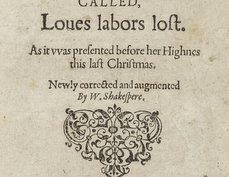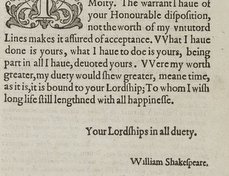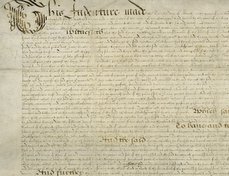Lawsuits or cases in law
Lawsuits in the Westminster courts of Chancery, Requests, and Star Chamber began with four alternating declarations, continued with interrogatories and depositions, and ended with final judgments. (For lawsuits in Coram Rege or the Court of King’s Bench, see below.) The initial four declarations were also called pleadings. Cases in law might contain additional pleadings, including demurrers, which argued that the case should be dismissed on specified grounds, or tried in a different court.
The four alternating declarations, or pleadings, in most lawsuits are:
1 Bill of Complaint (also referred to as a Bill or a Complaint): plaintiff’s initial charges against defendant, addressed as a Bill, Petition, or Complaint to the appropriate royal officer (Lord Chancellor, Queen’s or King’s Majesty, Attorney General)
2 Answer: defendant’s response to plaintiff’s Complaint
3 Replication: plaintiff’s response to defendant’s Answer
4 Rejoinder: defendant’s response to plaintiff’s Replication
After the four alternating declarations were submitted to the court, plans were made for taking testimony from witnesses. Witnesses were named and specific questions were drafted. Witnesses were summoned by procedures recorded in books maintained by the court:
Appearance Book (including compulsory summons)
Witness Book (list of witnesses to be interrogated)
Once a witness appeared before an officer of the court, he or she would be asked specific questions, and the answers would be recorded. (Civil depositions were given in private, not before a jury.)
Interrogatories: List of detailed, numbered questions, called articles, addressed to named witnesses
Depositions: witnesses’ response to Interrogatories
After possibly repeating the interrogatories and deposition steps for various parties and witnesses, the court would take them into consideration and come to a decision:
Final Judgment: Court’s disposition of the case (fine, continuation, referral to a different court or institution, or dismissal)
Granted that documentation in most lawsuits is incomplete, this general structure applies to Bellott v. Mountjoy (1612), Bendish v. Bacon (1615), Witter v. Heminges and Condell (1619), Condell et al. v. Brend (1632, 1634), and Benefield v. Burbage (1635).
Remarkably, all the documents in the Bellott v. Mountjoy case of 1612 have survived, making it an excellent illustration of the structure:
Pleadings in Bellott v. Mountjoy
Bill of Complaint (submitted for Stephen Bellott) (January 28, 1612): REQ 4/1/3/1
Answer (submitted for Christopher Mountjoy) (February 3, 1612): REQ 4/1/3/2
Replication (submitted for Stephen Bellott) (May 5, 1612): REQ 4/1/3/3
Rejoinder (submitted for Christopher Mountjoy) (May 1612): REQ 4/1/3/4
Proceedings in Bellott v. Mountjoy
Interrogatories and Depositions I (ex parte Stephen Bellott)
Compulsory Summons (May 7, 1612): REQ 1/183 [fol. 269]
Witness Book (Easter term 1612): REQ 1/199
Interrogatories and Depositions I (May 11, 1612): REQ 4/1/4/1
- Deposition of Joan Johnson
- Deposition of Daniel Nicholas
- Deposition of William Shakespeare
Order (May 15, 1612): REQ 1/26 [p. 270]
Order (June 15, 1612): REQ 1/26 [p. 343]
Interrogatories and Depositions II (ex parte Stephen Bellott)
Witness Book (Trinity term 1612): REQ 1/199
Interrogatories and Depositions II (June 19, 1612): REQ 4/1/4/2
- Deposition of Daniel Nicholas
- Deposition of William Eaton
- Deposition of George Wilkins
- Deposition of Humphrey Fludd
- Deposition of Christopher Weaver
- Deposition of Noel Mountjoy
Interrogatories and Depositions III (ex parte Christopher Mountjoy)
Witness Book (Trinity term 1612): REQ 1/199
Interrogatories and Depositions III (June 23, 1612): REQ 4/1/4/3
- Deposition of Christopher Weaver
- Deposition of Noel Mountjoy
- Deposition of Thomas Flower
Final order (June 30, 1612): REQ 1/26 [p. 421]
Additional information
Bills of Complaint are not necessarily dated, but may be endorsed with a date, or may contain internal dates. These and other pleadings tend to be formulaic and redundant. The kernel of the suit may be found in a single sentence within a single document. The answer may contain both a summary of the plaintiff’s original complaint and the defendant’s initial response. The replication and rejoinder may add new information, but often will merely reaffirm what has already been stated. The rejection of a charge made by an opponent is typically introduced by the phrase “Without that that …”
Interrogatories were usually compiled on behalf of the plaintiff or the defendant. Multiple interrogatories may be compiled, for the various parties and witnesses.
Depositions are explicitly dated. Witnesses or deponents are identified by name, occupation, place of residence, and age (the latter always qualified with “or thereabouts” or “or above”). Depositions are in the hand of a court official, but are signed with the personal signature or mark of the deponent.
Because depositions generally begin with direct answers to questions, and because the answers tend to re-formulate the questions, the language of depositions may be impersonal. However, if a deponent wants to add something more, an answer may be extended and personalized with a formula such as “And he further sayeth …”
The C 24 series, called “Town Depositions” because the depositions were taken in London, is an immense collection. The testimonies of the deponents are recorded on sheets of paper of uniform size. These are folded in half and stacked with the relevant Interrogatories. The name of suit (plaintiff v defendant) is written on the outside of the folded unit, the law term and regnal year recorded below. Often the names of all the deponents are listed on the outside of the folded unit; if not, they can be culled from the document itself. “Town Depositions” are accessed via the “Berneau Index” at the Society of Genealogists, London, on 16mm microfilm. Finding a particular name may be tedious and is sometimes difficult, but the Berneau Index makes it possible.
King’s Bench (Coram Rege)
Surviving documentation from the court of King’s Bench (Coram Rege) represents the side of the King or of the plaintiff only. Entries are in Latin, generally compressed, formulaic, and procedural. Ostler v. Heminges (1615) is the sole example of a King’s Bench suit among our Shakespeare documents.
Written by Alan H. Nelson









